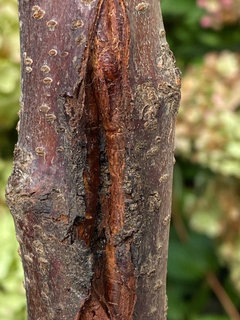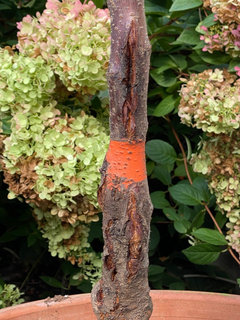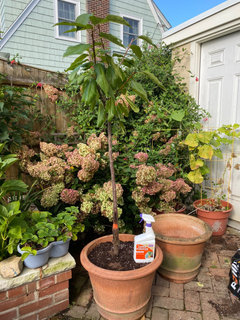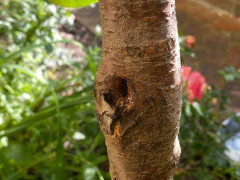Cherry bacterial canker fatal?
I have a cherry tree from Dave Wilson that has been in the ground two years. It has Van, Lapin, Black Tartarian and Bing comprising the 4 branches of the classic vase shape.
It is two years old, and sadly, appears to have bacterial canker. There are multiple soft, spongy spots that are dark underneath (where the wood should be light colored) when I try to carve them out. Last year I performed surgery to remove the bad spots, but there are other spots on the trunk.
This is hopeless, right? I should just pull the tree? Too bad, it was a really good cherry tree with fruit ripening one branch after the other.
I want to replace it with a similar tree. Anything I should do to sterilize the soil? Bacterial canker, pseudomonas, is not in the soil is it? Maybe some methyl bromide would do the trick.
Lifespeed
Comments (29)
fruitnut Z7 4500ft SW TX
13 years agoYes your tree is likely toast. But I don't see much you can do to avoid the same thing happening again. Methyl bromide is not the answer. The UCD publication I have says fungicides don't help.
I had several die this year when bacterial canker got into the Krymsk 5 rootstock. Are your problems on the rootstock or the scions?
lifespeed
Original Author13 years agoIt has it several places including the trunk and scions, but not the rootstock (although I doubt that matters). I wish I had known to check the tree when I bought it.
There is a cherry orchard two miles from my house; the conditions are essentially the same. How do they manage to keep the trees alive?
Related Professionals
West Milford Landscape Architects & Landscape Designers · Arnold Landscape Architects & Landscape Designers · New Mexico Landscape Architects & Landscape Designers · McKinney Landscape Contractors · Aberdeen Landscape Contractors · Brunswick Landscape Contractors · Choctaw Landscape Contractors · Deer Park Landscape Contractors · East Haven Landscape Contractors · Eureka Landscape Contractors · Middle River Landscape Contractors · Mission Bend Landscape Contractors · Pleasant Prairie Landscape Contractors · San Carlos Park Landscape Contractors · Seymour Landscape Contractorssautesmom Sacramento
13 years agoThis rootstock chart indicates some cherry rootstocks are more resistant to diseases, including bacterial canker, than others.
Carla in Sac
Here is a link that might be useful: Rootstock chart
oregonwoodsmoke
13 years agoThe cherry trees my son bought this last spring had canker. He pulled them out and got a refund (they obviously came with it.)
The planting holes have sat empty, and in the spring the holes will be planted with non-stone fruits, with the hope that they won't get canker from the soil. I figure it is too much risk to place another cherry, or closely related variety, into the same location.
lifespeed
Original Author13 years agoSupposedly copper and streptomycin can have a modest protective effect. And fumigating with methyl bromide to reduce ring nematodes is helpful. Don't know if I have a nematode problem, and if I did how I would manage to get my hands on methyl bromide. I think the controls on that stuff are strict.
I'll post a picture of the tree. I'm pretty sure it is BC, but a picture never hurts.
calistoga_al ca 15 usda 9
13 years agoWhen you make a picture make a print also and take it to your local county extension service. I have my doubts about your diagnosis. Al
tcstoehr
13 years agoBC is often contracted thru cuts in the above-ground portion of the tree. Pruning cuts are a major source and it is often recommended to prune in dry summer weather so cuts can heal before BC can get to them. Soil fumigation I suspect would be of little use.
> There is a cherry orchard two miles from my house...
> How do they manage to keep the trees alive?Yeah... me too. I suspect lots and lots of copper-based sprays on a regular basis. There are peach orchards near me and I know for sure they spray at least 5 times per season.
Another thing I've wondered about around here is that there is no shortage of very old and large sweet cherry trees that receive *no* spraying, and do appear to have BC. Where I used to live there was one in my yard. And now there's one next door on each side. The old-timers that planted those trees assure me that they are at least 40 years old. I think they survive because they are allowed to grow vigorously. They are also quite unproductive.
alan haigh
13 years agoI've never thought BC was a death sentence. Stressed cherries in my nursery get canker fairly commonly and recover- but I've never had a pathologist look at tissue so maybe the cankers are something else.
lifespeed
Original Author13 years agoOK, internet plant pathologists, a picture is worth a thousand words. Yellow grafting wax is where I sealed up the surgery scars following a light torching with propane and some copper spray.
What you can't see in the photos is that the affected areas are spongy, and if I cut them away the wood underneath is dark brown, rather than the light tan you would expect. Clearly something is wrong.
{{gwi:124792}}
{{gwi:124793}}
{{gwi:124794}}thomis
13 years agoThat's exactly what my Montmorency on Gisela 5 looked like this summer. It was a three year-old tree growing beautifully and suddenly died in mid August. Symptoms began as leaves started to turn yellow near the bottom of the tree. The yellow leaves migrated to the upper canopy while brown leaves replaced the yellow leaves. It took about a week for the tree to turn entirely brown. The bark on the limbs looked EXACTLY as those in your photo.
Someone on this forum, I think it was oregon smoke said "you can't grow cherries in zone 7? that's just weird".
I figured there had to be a more intelligent diagnosis.tcstoehr
13 years agoYour last picture looks just like regular bark spread patterns, no problem.
However, I would like to comment on the lower scar in the top picture. I went round and round about this exact type of scar in another thread. Those people thought it was physical damage healing up. In my opinion, this is a canker site that at one point was weeping fluid and/or gum. The canker has backed off to the point where the wound can heal up. I have seen this over and over again in my (now gone) sweet cherry trees. In the cool, wet spring these lesions appear and drip fluid and produce gum. Later, in the warm, dry summer the wounds heal up as the canker passes its peak activity and the weather is conducive towards active healing. I would agree with Harvestman that it isn't necessarily a death sentence, although I did have a Sam that had a huge problem like this on its trunk and the whole tree died. I think my other sweet cherry trees, like yours, may be able to survive the outbreaks and recover. Although in the end I would think that their lives would be shorted to some degree.lifespeed
Original Author13 years agoThe scars in the last picture are the same thing as in the first, the picture just isn't well-focused enough to see.
olpea
13 years agoI wouldn't use the wound dressing. Just a place to lock in dampness at the bark/dressing interface.
A torch might actually damage/kill the surrounding bark, which may be hard to distinguish from canker spread. Torches just aren't very precise tools.
If you want to try to sterilize the wound, I've used hydrogen peroxide on a wound and the canker healed up without any spreading. But it might well have healed up without the peroxide. I've also used copper on wounds, which is a pretty good bactericide.
Methyl bromide is more than just a restricted product. In KS it takes a special license (and training) beyond a typical pesticide applicator's license.
You might try a fall, and/or spring dormant spray(s) of copper to try to knock the innoculum down.
alan haigh
13 years agoI would simply follow recommended procedures based on research. Of course if you follow your hunches you just might discover something that would be worthy of research- like the hydrogen peroxide idea.
Cornell has very specific recommendations for treating BC and you can view their 2010 pest management guidelines on-line last I checked.
lifespeed
Original Author13 years agoCopper, streptomycin, and methyl bromide (specifically for ring nematode increasing susceptibility) are all recommended by UC Davis, which is in the same are that I live. I doubt I would be able to use methyl bromide, nor do I know if it would help. I would have to check for the nematode problem first.
olpea
13 years agoIt's probably because strep is not labeled for sweet cherries (or peaches).
That doesn't explain why Davis is recommending strep, as Lifespeed indicates (Lifespeed, I haven't been able to find where Davis is recommending strep, can you point to a link for me?)
If Davis is recommending strep, perhaps it's an obscure comment.
Sort of like Cornell when discussing bac. spot says, "Unfortunately, there are no materials registered for bacterial spot on prunes and plums. Despite the effectiveness, do not make a dormant copper application for bacterial spot. Copper applications to manage bacterial blast are still allowed whether or not the planting has bacterial spot."
Had to laugh when I read that one.
lifespeed
Original Author13 years agoMy mistake, the strep recommendation was from somewhere else. It is supposedly less effective than copper.
zelda77
10 years agoI'm an organic gardener with a Black Tartarian 4 years old that came down with bacterial canker early last spring. Until then none of my fruit trees had any problems. I think the tree is about half dead, although it put out new branches which up to the end of the growing season had no symptoms. The tree has the typical yellowish dischage in dozens of places on all the older branches and yellow leaves. I sprayed it very often with copper sulfate until all the leaves dropped. I almost cut it down but decided to see if the infection was treatable - the tree is large and I'd like to save it. Won't know until spring if it survived and has enough stored energy to leaf out. The other suggestion I read was to keep the tree well fertilized. Like other posters I'm curious about why orchard trees and older trees either survive an infection or learn to live with it and why some varieties are more resistant - what confers this resistance? I'm still doing a lot of reading.
Follow Up: sprayed until after leaf drop, wrapped the tree for winter to keep the copper spray on the tree. The tree has been sprayed for two years. It has one branch with leaves and flowers (two sets), several with leaves only, and several dead. This is not a productive, fruit bearing tree and it will be cut down as soon as the weather allows. I also plan to dig the roots out. I think it is on Gisela 5, which is a shallow sparse root system. In the case of my tree, the bacterial canker is fatal. But I've learned a lot about caring for my stone fruit trees. BTW like the person who posted above, my tree came from Dave Wilson Nursery. While two cases don't show a trend, it might be appropriate for potential customers to question them about the frequency of canker in their cherry trees, and ask if they have fumigated or will. Once the roots are out I'm going to amend the soil and plant another sweet cherry tree, different variety, and see what happens.
This post was edited by zelda77 on Sat, May 10, 14 at 18:12
letsski
10 years agoMy Stella tree developed BC about 12 years ago. I started spraying with copper and tried the blow torch on open, oozing wounds.
So far, my tree has hung in, putting out new growth and still producing good fruit, although i do continue to lose some of the older branches.
The tree is now 25 years old. I'm located in San Mateo in the SF Bay Area.
arthag
9 years agoto letsski-
I'm addressing cranker on my 35 year old bing cherry and wonder what your blow torch method is. I've used copper spray, pruned heavily and cut out infected areas along the trunk.
I don't want to take the tree down until I've done all I can to save it.lifespeed
Original Author9 years agoOP here, my cherry tree survived and walled off most of the wounds. Still have one oozing wound. I prune in summer now for this true, supposed to reduced the spread of the disease.
alcedo 4/5 W Europe
9 years agoin a fight against bacterial canker
there are some rules on pruning cherry treesStart by pruning just after cherry pick never do this in a winter period the infection pressure is very high.
Prune or saw branches back to a stub, this residual stump will dry out, this dehydration stub forms a perfect natural barrier against BC
in my region we prune all stone fruit in this way, the infections remain low.Tip: at hail damage spray with copper to prevent infections
wolfridgeil
8 years ago5-31-15
Yorkville, IL (SW exurb Chicago)
I think I am getting a brutal education on bacterial canker in sweet cherry.
Please provide advice as to whether I should remove my ?infected? trees immediately.
I have four (4) semi-dwarf cherry trees - Montmorrency, Balaton, Bing, and Black Tartarian. They are Starkbros trees - don't know rootstock. The two tarts are about 10 yrs old and the two sweets are about 5-6 years old. They are planted about 25 feet apart in a 4-corner pattern with the sweets opposite each other and adjacent the two tarts. I am gravely concerned that the sweets, if truly infected, are going to infect the highly prolific tarts, each of which in all reasonable weather years have a full load of fruit. Presently I have no significant insect problem (I hope) - PC seems non-existent but lately finding occasional green soldier bugs and occasional lady bug-like insects.
On both sweets, I have been monitoring a trunk split problem since early spring which I thought was attributable to growth and weather. I also had quite a few brown buds that I believe are blossom blast. I again thought that was weather damage. I did see flowers but not many compared to the tarts - but as I stated some buds were 'damaged' and I presumed the sweets were just less hardy than the tarts. Presently lots of green leaves, but only scattered fruit. Always on the lookout for the dreaded fungal leaf spot, I became alarmed this week when leaves started dropping. Leaves are yellow with angular spots. The bark splits appear to have gotten uglier and are oozing. From the reading I have done in the last few days - it appears the trees have classic bacterial canker symptoms. I can see I violated several cultural principles - namely planting young trees with old trees, not protecting the trunk during winter, and last year I made some minor pruning cuts to remove lower limbs - and though it was dry weather and I used pruning paint I did not disinfect the cuts or let cuts dry out, and I did not leave stubs either as I have read on this site is a good way to insure the pruned area dries out. Instead I removed nuisance lower sprouts right up against the trunk. Also I have deer nibbling branches probably at least a dozen times per year.
I've got photos on these pages...
page1 Bing, page2 Black Tartarian
url to page1...
http://home.comcast.net/~8863184tuc/site/
to get to page2 click on link at top of page1 or use...
Julie Lamberts
3 years agoI had bacterial canker on the main trunk of a 3 year old peach tree. It was half of tge trunk and tge gummosis was spreading up the trunk. I applied biodynamic tree paste I made with some day old dried chicken manure and healthy forest soil etc. It seems to be working. The hummus is has drastically reduced, what was spongy trunk has become solid again. It looks like it is healing. The rationale here is tgat the bad bacteria in tge canker has been overcome by the beneficial bacteria in the tree paste. It's worth a try.
ColleeninMHD 6a
2 years agoMy Dave Wilson trees have what believe is canker. These trees are one - 2 years old. Utah Giant dwarf (Newroot 1) multi bud sweet cherry on (Newroot 1) and another I can’t find tags for. I am finding it very hard to wait until leaf drop to treat with copper. ( zone 6a Massachusetts) I am praying over these babies to survive.












sautesmom Sacramento